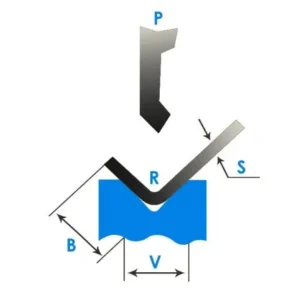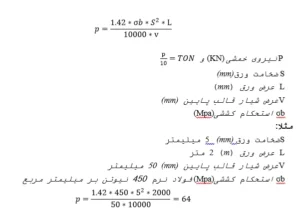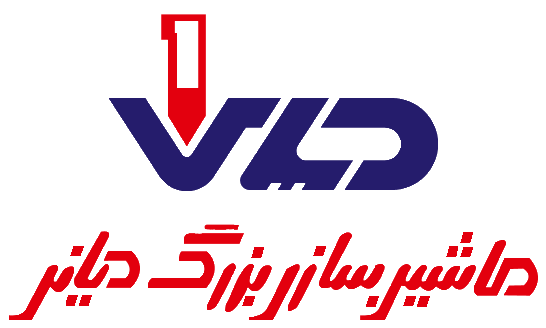How to Calculate the Tonnage (Power) of a Press Brake?
One of the essential processes in metal industries is the bending of metal sheets. To perform precise and effective bending, the correct tools must be used. A commonly used tool for bending metal sheets is the press brake machine. By selecting the right press brake, you can ensure that your processes are executed accurately. Choosing the right press brake depends on selecting or determining the correct tonnage and the maximum working length. In this article, we will guide you on how to determine the appropriate tonnage for bending different types of metal sheets by knowing key parameters, such as sheet length, thickness, and more.
It is important to note that the skilled and expert consultants at Dayyani Grand Machine Manufacturing are always available to assist you in selecting the right press brake. By the end of this article, you will have learned how to calculate the required tonnage to purchase a press brake suitable for bending the desired metal, as well as understand the disadvantages of choosing a press brake with either more or less tonnage than needed. We have aimed to provide the simplest calculation formula, complete with examples for clarity.
Dayyani Grand Machine Manufacturing is proud to contribute to expanding its customers’ technical knowledge by providing practical articles on its website. Additionally, a summary of these calculations is available as a table alongside Dayyani Grand Machine Manufacturs press brake machines, helping you easily find the required tonnage.
What Is the Basis for Determining the Power of a Press Brake?
When searching to buy a press brake online, in stores, or directly from manufacturers, you may frequently encounter the question, “What bending power do you need for your press brake?” To address this, manufacturers often refer to the term “press brake tonnage.” Press brake tonnage is a measurement of the force required to bend a metal sheet in a press brake machine. This measurement is defined in two units: Newtons per square millimeter (N/mm²) and kilograms per square millimeter (kg/mm²). To convert from Newtons to kilograms per square millimeter, simply divide the value by 10 (the exact value is 9.8).
Accurate calculation of the required force for precise and safe bending is essential. Therefore, as a press brake operator, you should be able to calculate the required tonnage or consult a reliable seller who provides correct information. In the following sections, we explain how the specialists at Dayyani Grand Machine Manufacturing calculate and recommend the required press brake tonnage for their clients to prevent issues during the bending process.
As you may know, different countries use varying units of measurement. While some countries use metric units, others follow the imperial system. Since most countries use the metric system, we will also use metric units in our calculations and examples in this article.
How is the Required Tonnage Calculated?

Currently, Two Main Formulas for Calculating Press Brake Tonnage Are Popular
The first formula is commonly used in China, while the second formula is preferred in other countries. Regardless of the formula applied, the calculated tonnage (pressure) required for the press brake is fundamentally the same. Below, we examine these two formulas in detail.
Formula 1 for Calculating Press Brake Tonnage?

In this Formula, the Tensile Strength of Standard Steel is Considered
In this formula, pp represents the tonnage or pressure required for bending, SS is the sheet thickness, LL is the sheet length, and VV is the die opening. Typically, manufacturers’ tables use a sheet length of one meter, which is also the standard for press brakes manufactured by Dayyani grand machinery . Please use millimeters as the unit for thickness, die opening, and sheet length.
For example, let’s say you want to purchase a press brake to meet your needs. Suppose you plan to bend sheets with a maximum thickness of 5 millimeters. In this case, the die opening can range between 25 to 70 millimeters (5 to 14 times the sheet thickness). A wider die opening reduces the required bending force. We have explained more about die opening and its relationship with sheet thickness in the article Choosing the Appropriate Die Opening (V) for Bending on Press Brakes.
In this example, we will assume a die opening of 50 millimeters and a bend length of 2 meters (2000 millimeters). The calculated value is as follows:

To Convert the Value from Newtons to Kilograms, Divide by 10
This gives a result of 65 tons. For convenience and faster calculation of press brake tonnage, you can use the formula in the following format to directly obtain the tonnage of the press:


The Difference Between 65 Tons in Formula 1 and 64 Tons in Formula 2 is Minimal
This slight difference is due to rounding in the first formula. With closer inspection, we see that both formulas are essentially the same, with Formula 1 being a simplified version of Formula 2 specifically for mild steel.
The advantage of Formula 2 is that it allows you to directly calculate the required force by knowing the tensile strength of any metal alloy.
The key parameters for estimating the required tonnage include the sheet length, sheet thickness, die opening, and the tensile strength of the metal to be bent. The sheet thickness and length are usually known to Dayyani Grand Machine Manufactur’s press brake customers. However, some customers may be unfamiliar with the required die opening dimensions and shape. Additionally, you may need to perform calculations for bending other metals with different tensile strengths compared to standard steel sheets. Therefore, we have provided a table of the most common metals and their tensile strengths for reference.
| Metal Name | Abbreviation | Tensile Strength (MPa) | Common Applications |
|---|---|---|---|
| Aluminum Series 1000 | AL1050 | 105 – 145 | Electrical conductors, food containers, reflectors |
| AL1060 | 80 – 130 | Corrosion resistance, good formability | |
| AL1100 | 90 – 165 | General sheet work, low-pressure panels | |
| Aluminum Alloy 5005 | H12 | 105 – 145 | Food storage, chemical containers |
| H14 | 125 – 165 | Anodized aluminum parts, HVAC equipment | |
| H16 | 145 – 185 | ||
| Aluminum 2030 | AL2030-2036 | 290 – 340 | Bolts, threaded rods |
| Duralumin 2014-2024 | Duralumin | 260 – 480 | Aircraft, rods, military applications |
| Structural Steel Soft | ST37 | 360 – 510 | Construction, steel profiles |
| High-Strength Steel | ST52 | 490 – 630 | Metal structures, machine frames |
| Stainless Steel 302 | Stainless | 600 – 750 | |
| Silicon Steel | Silicon | 550 – 650 | |
| Tungsten | W | ||
| Lead | Pb | 25 – 40 | |
| Tin | Sn | 40 – 50 | |
| Zinc | Zn | 150 – 250 | |
| Copper | Cu | 220 – 400 | |
| Brass (70:30) | Brass | 330 – 530 | |
| Brass (60:40) | Brass | 380 – 490 | |
| Phosphor Bronze | Phos Bronze | 400 – 750 | |
| Nickel Silver | 350 – 700 | ||
| Cold-Rolled Iron | 320 – 380 | ||
| Steel 0.1% Carbon | 320 – 400 | ||
| Steel 0.2% Carbon | 400 – 500 | ||
| Steel 0.3% Carbon | 450 – 600 | ||
| Steel 0.4% Carbon | 560 – 720 | ||
| Steel 0.6% Carbon | 720 – 900 | ||
| Steel 0.8% Carbon | 900 – 1100 | ||
| Steel 1.0% Carbon | 1000 – 1300 | ||
| Nickel | NI | 440 – 630 |
- Choosing a Stronger or Weaker Press Brake You might wonder about the impact of purchasing a press brake with lower or higher tonnage. Below, we discuss the drawbacks of each option.A : Purchasing a Lower-Tonnage Press Brake to Save on Initial CostsBuying a press brake with insufficient tonnage poses a significant risk. A press brake with lower tonnage will not be capable of bending sheets with the maximum length or thickness you have in mind. This limitation places extra strain on the machine and can damage critical components, such as the cylinders, punch, die, and more. Additionally, the quality of your bends will suffer due to the stress on the machine’s structure. Therefore, we strongly recommend avoiding press brakes with tonnage below your requirements.
B: Purchasing a Higher-Tonnage Press Brake
Most manufacturers recommend adding 5 tons of capacity per meter of machine length. This is because, over time, the machine will experience wear and may not perform as it did on day one. Additionally, you might occasionally need to bend slightly thicker sheets. While a higher tonnage press brake may involve a higher initial purchase cost, it significantly reduces maintenance and repair expenses in the long run. However, we do not recommend exceeding 10% more tonnage than your maximum requirement, as this adds unnecessary costs and can increase the final product price.
At Dayyani grand machinery Manufacturing, we take pride in ensuring that the rated power of our machines matches the specifications indicated. In the design and construction of our cylinders, we use only the highest quality materials, adhering to engineering standards and factoring in the 5-ton extra capacity per meter length. Thus, you won’t encounter pressure loss in the cylinders of our machines. We recommend considering at least a 10-year future requirement when purchasing. Dayani’s press brakes are built to serve you reliably for many years, so planning for an additional 10% in power may help address potential needs you might not currently foresee.
